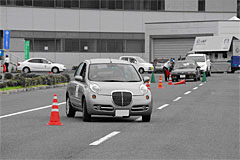April 9, 2008
The JAMA /JAF/JTSA 2008 Senior Drivers’ and Safe-Driving Programs
Will Take Place at 70 Locations Nationwide, from Hokkaido to Kyushu
One-Day, Hands-On Programs Teach Skills to Help Reduce Road Accident Occurrence
The Japan Automobile Manufacturers Association (JAMA), the Japan Automobile Federation (JAF) and the Japan Traffic Safety Association (JTSA)—with crucial support from the National Police Agency, individual prefectural police headquarters, prefectural traffic safety associations and other organizations—are again this year jointly sponsoring the JAMA/JAF/JTSA Senior Drivers’ Program and the JAMA/JAF/JTSA Safe-Driving Program throughout Japan. Drivers who have held a driver’s license for at least one year are eligible to enroll in these one-day sessions that train participants in practical safe-driving skills.
Road Accident Trends in 2007: Accidents Caused by “Senior” Drivers Double from a Decade Ago
Road fatalities in Japan in 2007 totalled 5,744—608 fewer than in the previous year and the first drop below 6,000 since 1953. The roughly 830,000 road accidents represented a decrease of 6.1% from 2006, while the number of accident-related injuries was also down, by 5.8% to 1.03 million, marking declines in both these categories for the third consecutive year.
Road fatalities involving “seniors” (aged 65 or older) totalled 2,727, 82 fewer than in 2006. However, the share of elderly persons in total road fatalities rose from 44.2% in 2006 to 47.5% in 2007. Moreover, the number of road accidents caused by senior drivers and which resulted in injury or death more than doubled over the past decade (from 49,555 incidents in 1997 to 102,961 in 2007). According to the National Police Agency, the number of licensed drivers aged 65 or older again surged in 2007, by about 690,000 persons, to a total of 11.07 million drivers. This steady rise points to a continued increase in the number of road accidents involving persons in this age group.
Against this backdrop, the sponsors hope that, through the conduct of the two nationwide programs, more and more drivers will adopt safe-driving practices that will contribute to a further decline in road accident occurrence in Japan.
Overview of the JAMA/JAF/JTSA Senior Drivers’ Program:
Launched in 1996, the Senior Drivers’ Program enables elderly drivers to become more aware of their own driving habits and limitations and to develop safe-driving skills. Targeting drivers aged 65 or older but open to drivers who are at least 50, the program boasts a cumulative participation, in a total of 208 locations, of 4,350 persons, some of whom expressed the view that this program should be implemented in place of the “senior classes” currently offered at driving schools.
The program’s content covers matters that can be especially problematic for elderly drivers, including vehicle safety checks, driving posture, blind spots, airbag deployment, braking on slippery surfaces, right-hand turns at intersections, and crossing intersections in poor visibility. Hands-on sessions are followed up with question-and-answer periods between participants and instructors.
The 2008 Senior Drivers’ Program will be conducted in 35 locations from Hokkaido to Kyushu, with the inaugural session to be held on May 6 in Kyoto Prefecture.
Overview of the JAMA/JAF/JTSA Safe-Driving Program:
The Safe-Driving Program has been conducted since 1991 and is open to any driver, regardless of age, who has held a driver’s license for at least one year. The program enables drivers to advance their understanding of vehicle characteristics, performance limits and other factors, in order to improve their safe-driving skills. It also promotes a better awareness of the need to adopt safe-driving practices. By the end of 2007, this program had been held in a total of 353 locations with about 9,100 participants, some of whom commented that the program was helpful in making them more aware of, for example, their own vehicle’s performance and the importance of timely deceleration.
Program content begins with confirmation of driving basics, then moves on to driving on straight and curved roads, sudden braking, cornering, and many of the practical aspects of driving that are also covered by the Senior Drivers’ Program, thus providing participants with valuable pointers on how to react to and deal with real-life situations on the road.
The 2008 Safe-Driving Program will be conducted in 35 locations from Hokkaido to Kyushu, starting on May 18 in Saga Prefecture.
A JAMA /JAF/JTSA Senior Drivers’ Program session held in 2007

Smooth steering: Confirming the turning radius differential that results from swift veering around obstacles (“slalom driving”)
